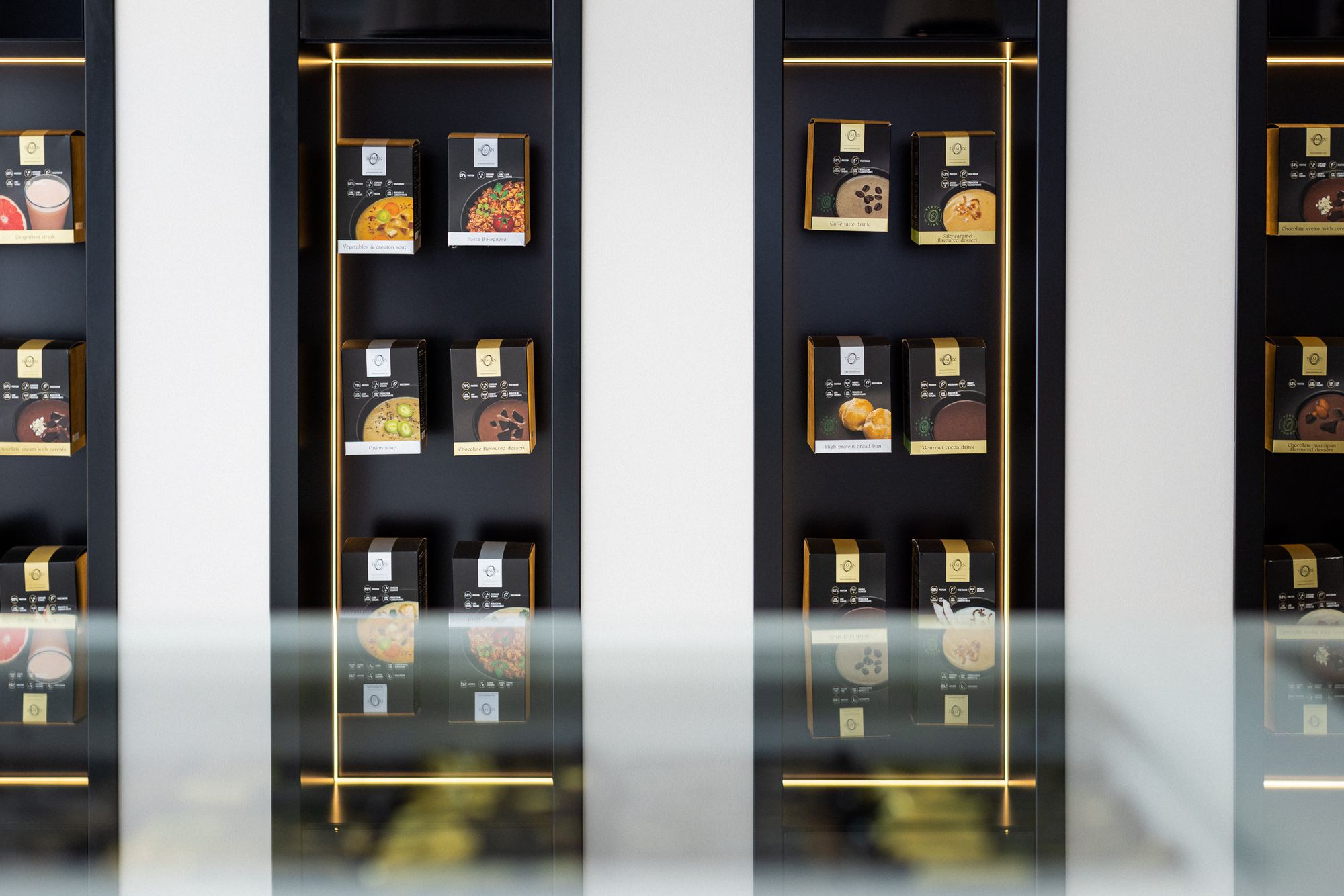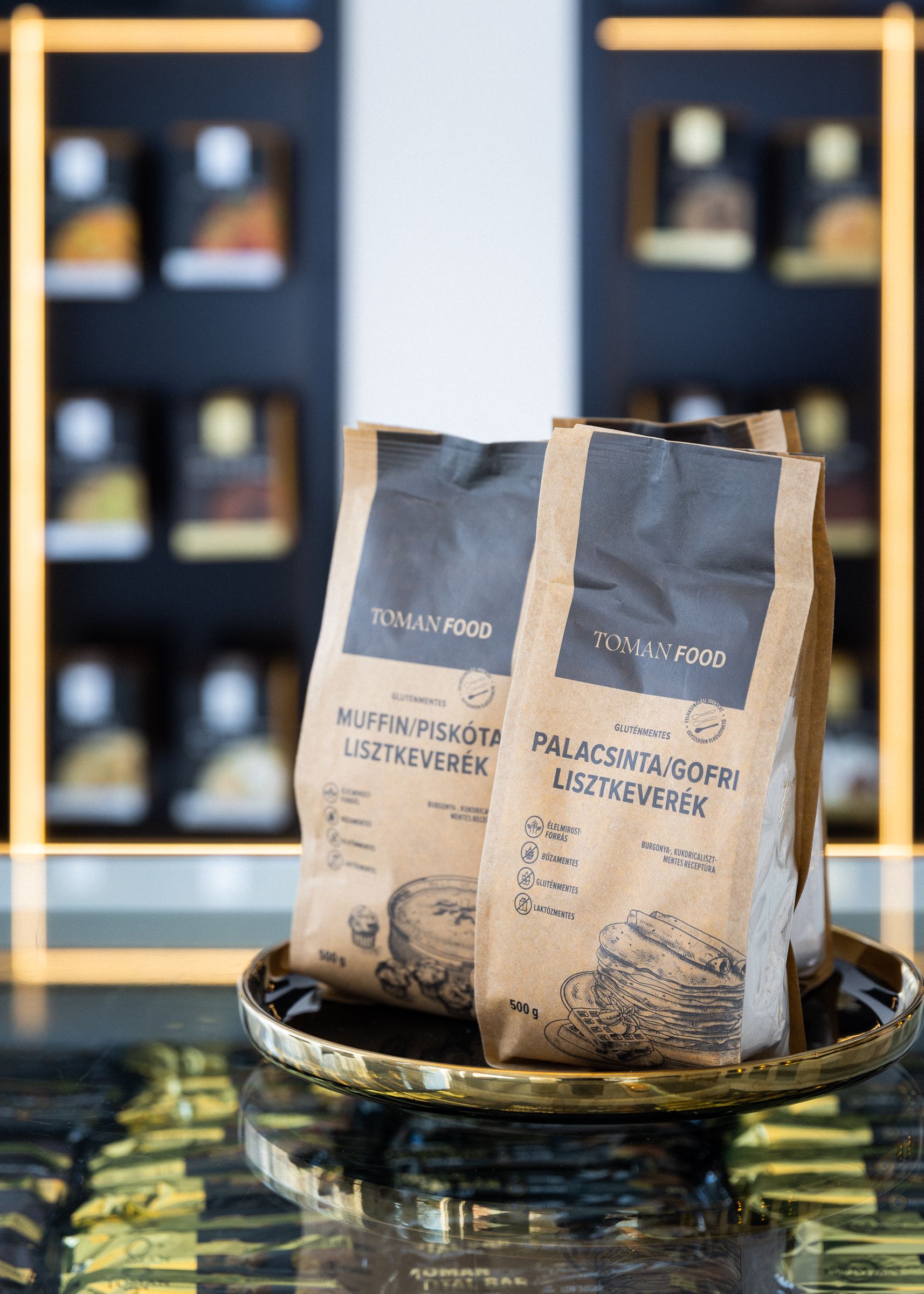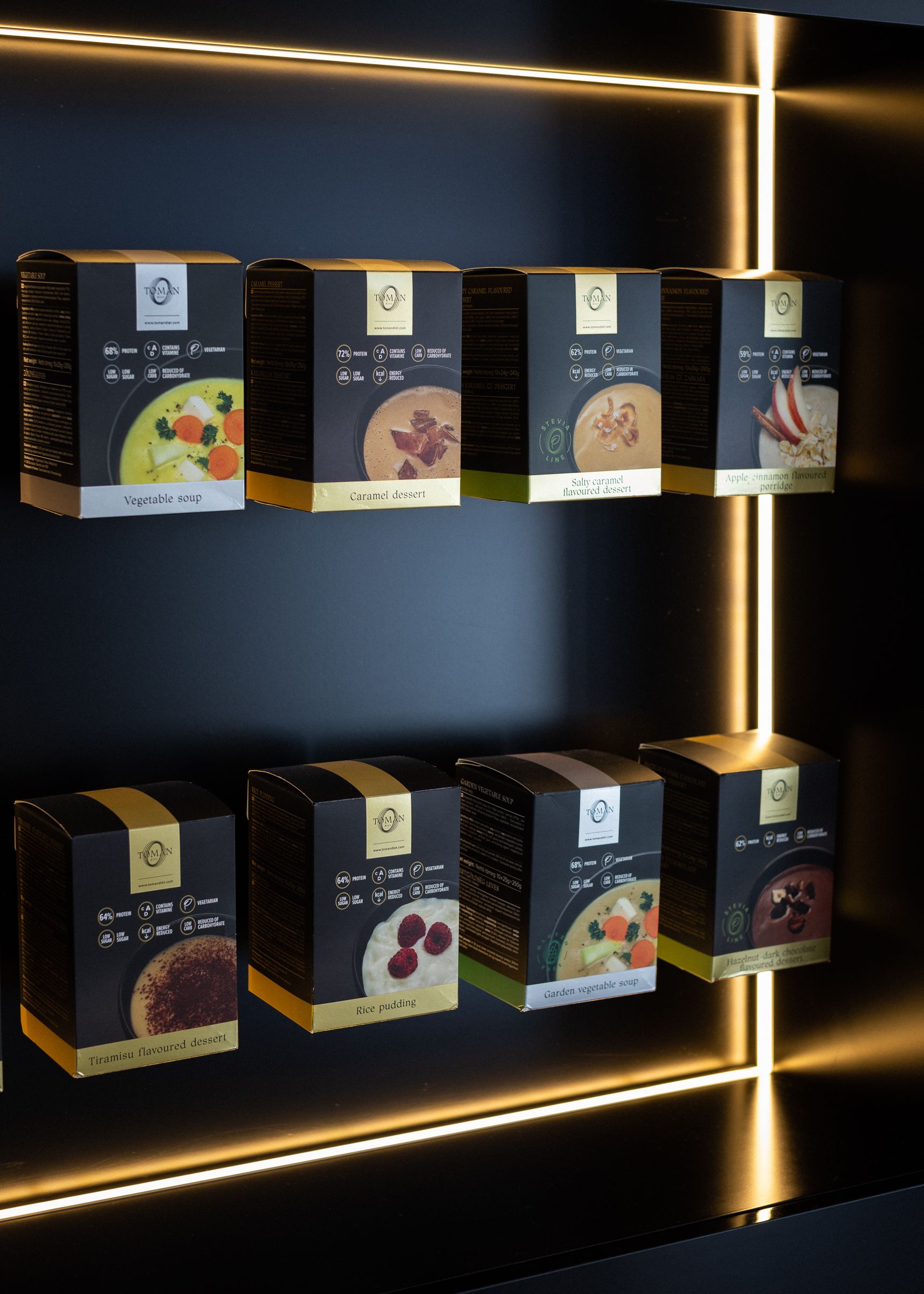She says she often gets a strange look when ordering chicken stew in a restaurant. Szabina Tomán is a successful businesswoman, known by many from the business show Cápák között (Among Sharks), and there is a fair number of people who would put her name in gold thanks to the lifestyle program she has developed. We caught up with Szabina at the Toman Diet headquarters, where she told us about diet misconceptions, women’s self-esteem and her mother’s chicken stew, which for her is the real deal with noodles and sour cream. Interview.
Szabina says she is very mindful of eating clean and consciously, but that doesn’t mean she’ll say no to a slice of good Italian pizza, for example—moderation and regularity are important, but you don’t necessarily have to deprive yourself of every delicious bite to feel good about yourself. Walking around the base on Szendrő Street, we felt that this place is not just a manifestation of a commercially successful business but an oasis where everyone leaves with a little more confidence than when they arrived—and it’s not necessarily just about the number of kilos they’ve lost.

For you, if anyone, nutrition has always been and still is central to your life. Of course, I suppose it has always had a different color: when you were a model, after you had a baby, and when you started your own brand. Can you tell us about these periods and your relationship with food and eating? In a previous interview, you also said that you love to eat…
Yes, but not just me: everyone in my family loves to eat. In Tatabánya, the cooking, the kitchen, was the heart of our living space; that’s where we spent most of our time. Our mother cooked very, very well. She knew all the ins and outs of culinary. I came from a background where I never paid much attention to nutrition. Instead, what mattered was the taste, the warmth of the family, or the idea that the prepared food should please everyone without having to cook five different dishes. Perhaps I was even a little overfed.
But when I started modeling, I got the opposite: “you can’t eat as much,” “only liquids!” and so on. I worked with a professional modeling agency that constantly warned me about everything—my skin tone, my measurements. Every time I had to start the casting week by going in on Monday and having my booker check me, tell me what I could and couldn’t do: for example, I couldn’t paint my nails, my hair. I started living by a rigorous set of rules: in order to be chosen for a job, I had to suffer for the kilos. Often they would put an apple or a diet soda in front of me—that’s what I could eat that day because I had a lingerie show the next day, for example.
Then I got a bit fed up with this: I missed home, missed my friends, and moved back home. I started a family, fell in love and got pregnant with my first daughter. I remember when I found out that I was expecting a baby, I sighed and said to myself: well, now I’ve got nine months where no one can tell me when and how much I’m going to eat. With that came the 30 kilos of excess weight, which eventually led to health problems (high blood pressure, high blood sugar level)—it was taking its toll on my body.


After giving birth, it wasn’t easy because you’re trying to do the old tricks that the booker said, but you can’t do that with a baby. I was very sad at the time—I was not only physically, but also mentally unwell. After all, in my group of friends, at my workplace, everyone was a size 36. Everyone expected you to look perfect, even after giving birth. Then came a drastic and conscious decision that I had to change that because I could no longer do to my body what I could do a few years before.
That’s where mindfulness and regularity started to play an important role in my life, in my diet. In fact, it was my daughter Amira who taught me to adapt to her rhythm (sleeping, feeding, breastfeeding, complementary feeding) and I started to eat like a baby: breakfast with her, an apple for ten, lunch with her, snack and dinner. Since I had to develop a system for her, I also started eating regularly and being conscious of what I was putting into my body. In no time at all, I had dropped 30 kilos and I even felt good: I wasn’t tired, I had more energy because I wasn’t taking in extra calories and unnecessary food. When I lost weight, many people asked me how I did it.

In fact, I owe the success of Toman to this, that it gave a solution to a problem that many women are still struggling with today, even though it was thirteen years ago.
Of course, I’m not denying myself good food now. When I travel abroad with the family, for example, I can’t resist a good Italian pizza—you don’t have to eat the whole thing, two slices are enough. If you have a steady 80%, you live in a system, then the remaining 20% of change is completely tolerated by your body. And that’s true for a lot of things, including organizing your day. If you have those points that you know you need to pay attention to, then you are stable and you can feel good while doing it. It’s the same with food.
What do you think are the biggest misconceptions about dieting?
A diet itself is not necessarily about losing weight. It’s very, very important to emphasize that the same [diet] is not suitable for everyone—that’s a basic rule. Toman is not for everyone either. When I started my company in 2015, I typed the word “diet” into Google: in 0.43 seconds, I got over a billion hits. Think about it: choosing what’s best for you out of a billion search results is very difficult. But it’s easy to fall for it: there were consumer pills that caused brain clots and heart arrhythmias in the past, and many women, many of our customers, still suffer from the complications—so it’s not a game at all.

Dieting is not torture, dieting is not starvation, dieting is not deprivation, because afterward, the body will fight back immediately. The condition of our gut flora is a crucial factor in almost all diseases, which is why it is worth being more conscious about what we eat for our health.
Most of the women at Toman are in their forties—many of whom we help with our experts to get through menopause: how to balance their hormones through diet or to keep their kidneys and liver functioning well. We have more and more conscious women who may not have been conscious at the beginning. This is a great thing!


People of my age group, or the forty-plus women, come to us having already tried all the diets and I have nothing new to show them; they are disappointed with everything. And when they realize that they can control their own bodies, their own weight, they burst out with the kind of confidence, the type of strength that is one of the best things to see in my work. When they start to control their own bodies and see the light at the end of the tunnel, then the sky is the limit!
With your book “Egészségesen, tománosan,” your aim was to encourage the reader to eat consciously while at the same time retaining the warmth and familiarity of home in the recipes. What does home mean to you when it comes to food, and how does it manifest in the book?
When we started thinking about the recipe book, the main goal was to make sure that people who love the classic Hungarian flavors don’t lose them because they have changed their lifestyle. We built up the book so that the family wouldn’t feel too much of a change. When I started dieting, I remember the system turned upside down right away because I wanted to change everything and immediately, and I realized that I couldn’t do it that way. We do need those “crutches,” whether it’s the taste or the feeling of home that we’re used to. So, for example, let’s have a “Hortobágyi palacsinta” (Hungarian food specialty, savory pancakes filled with meat— Transl.) which is similar in taste too, but is reformed in its composition and ingredients and is good for the body. It’s important that everyone finds something to their liking at a Sunday lunch: just because mum is on a diet, there can still be food on the table that is healthy yet brings back the classic flavors.

And some more questions about food...
The most perfect thing I have ever eaten:
My mother’s chicken stew.
Is there a food you’d prepare even at 2 am?
Sure, there is, and that’s the pancakes. All shapes, all varieties. The kids love it too, so it’s the favorite.
What is the one food you would pass on in a time capsule for future generations?
Traditional Hungarian dishes. Because I see that everyone is constantly rethinking everything, and I think there are things that you have to stick to. Hungarian traditional dishes are like that.
What do you think should not be missing from the Sunday lunch table?
The broth. In our house, the broth is a staple of our Sunday lunch.
Are there any ingredients or dishes that you have rediscovered in recent years?
Kale and pickled products are two things that I feel have come back into our diet. Pickled cucumbers or fermented vegetables, which I actually remember being stored in huge jars in my grandmother’s garden.
What’s your favorite texture?
Huh, it’s the sticky-crunchy one; I love that! I love Asian food because [this texture] is popular there.
Is there anything that can chase you out of the world?
Imagine that I like everything; I am omnivorous. Though one of such bad memories happened to me in Beijing, back in the early 2000s, where I had to pick out a live snake. When you have to choose a live animal to eat afterward. I can’t do that. I don’t like that.
Granny’s cooking:
When I was a kid, I spent many summers at my grandmother’s house, and I remember every morning she would be waiting in the kitchen with some kind of sponge cake. I actually think it was the feeling rather than the cooking: that warmth, that family feeling was an incredible thing, and I hope my children will carry that on.
Something you couldn’t resist at the school cafeteria:
Hm, there were… I might be saying something terrible, but it was the typical hot sandwich: it had pizza or some kind of cream, it was sprinkled with cheese, and it was this long bun shape. It was soft inside and crispy on the outside, so yeah, I probably couldn’t resist that classic grilled sandwich.
What comes to your mind when you hear ‘kitchen disaster?’
Several things: the first and most recent memory is the mess in the kitchen after my husband’s cooking, but such are the memories following Christmas when we host a large family of ten or twelve people. For me, it’s a kitchen disaster.
Food that makes the world a better place:
Well, yes, this is my mother’s chicken stew. I don’t think you can replace those warm evenings anywhere in the world, like the smell and taste of my parents’ house. There’s no place in the world like it, and I’ve been to many places.
If you’d like to hear more questions we asked, check out the video.
Photos: Balázs Mohai
Szabina Tomán | Facebook | Instagram
Toman Diet | Web | Facebook | Instagram

Leaving traces in the landscape: the visual diary of Réka Neszmélyi and Balázs Máté on the contrasts of Mongol nomadic life
Where it all began | We visited Silicon Valley










